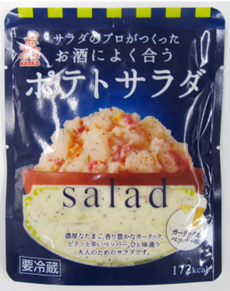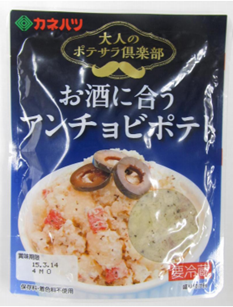November 30, 2016
Trademark News
IP High Court holds novel food package not necessarily protected as identification of source
In a judgment issued on October 31, 2016, the Intellectual Property High Court rejected the Plaintiff's claim that the Defendant's use of a similar food package constitutes unfair competition. In doing so, the court held that the food industry is inventing and developing various kinds of new products every day, and that the fact that a company has created a novel packaging design/configuration of goods does not necessarily mean that the said design/configuration will become recognized as an identification of source (IP High Court Case No. 2016 (ne) 10058).
Background
The Plaintiff (Kenko Mayonnaise Co., Ltd.) produced and sold potato salads contained in retort pouches. The name of the product was "POTATO SALAD made by salad professionals and matches well with alcoholic beverages" (in Japanese).
(* Copied from the IP High Court judgment)

The Defendant (Kanehatsu Co.) also produced and sold potato salads contained in retort pouches. The name of the product was "ANCHOVY POTATO that matches with alcoholic beverages" (in Japanese).
(* Copied from the IP High Court judgment)

The Plaintiff filed an action against the Defendant before the Tokyo District Court, asserting that the Defendant's act constitutes unfair competition under Article 2(1)(i) of the Unfair Competition Prevention Act (the "UCPA"). Article 2(1)(i) of the UCPA provides that an act of using an indication of goods that is identical or similar to a well-known indication of goods of another person in a manner that would cause confusion constitutes unfair competition. The Plaintiff argued that its product package was a well-known indication of goods, and that the Defendant committed unfair competition by using a similar product package. The Plaintiff sought injunction and damages.
In the first instance, the Tokyo District Court found the Defendant's product package dissimilar to the Plaintiff's product package, and denied the Plaintiff's claim. Plaintiff appealed to the Intellectual Property High Court (the "IP High Court").
Judgment
The IP High Court also found that the Defendant's product package is dissimilar to the Plaintiff's product package, and rejected the Plaintiff's appeal.
The common features between both packages, amongst others, were: (i) the navy blue color on the background; (ii) indication of name of the products in big white font on the upper side; and (iii) the transparent window for seeing the products from outside, located around the middle of the image of the potato salad. The Plaintiff argued that the combination of these features was novel and did not previously exist in other products.
However, the court held that, since the food industry is inventing and developing various kinds of new products every day, the fact that the Plaintiff created a novel package design/configuration of goods does not necessarily mean that the said design/configuration will become recognized as an identification of source of the Plaintiff. The court pointed out that it is just ordinary to show the letters in white when the packaging color is in dark colors, and that the feature of making the products viewable from outside through a transparent window is also ordinary for food products. The court therefore held that the combination of these features, even though it did not previously exist, could not function as an identification of source of the Plaintiff's products.
Both the Plaintiff's products and the Defendant's products were sold at about just a few hundred Japanese yen, and were products consumed for daily lives. The Plaintiff argued that the relatively cheap price of the products makes it unlikely for consumers to compare the products closely. On this basis, the Plaintiff argued that if the package designs look similar as a whole ? leaving small differences aside ? this will likely create confusion between the Plaintiff's product and the Defendant's product.
The court found, however, that the only similarities between the products are the background color, and even though the consumers may not pay close attention to the small differences in details, they would still likely differentiate the products by focusing on configuration and design of the packaging, as well as who manufactured the products, instead of merely looking at similarities in the color of the packages.
The Plaintiff also argued that the concept of the products are similar, in a sense that the products both incorporate the key words and ideas of "a potato salad that matches with alcoholic beverages."
However, the court found that the biggest letters on the packaging are "POTATO SALAD" on the Plaintiff's product and "ANCHOVY POTATO" on the Defendant's product, and it is not reasonable to extract only a few words such as "alcoholic beverages", "match" and "potato" from the entire wordings on the packages when comparing the Defendant's product with the Plaintiff's product.
Comments
Overall, what we can draw from this IP High Court judgment is that the level of distinctiveness required for the package design and/or configuration of products to be deemed as an "indication of goods" as provided in Article 2(1)(i) of the UCPA is quite high.
The Plaintiff argued that the Plaintiff sold the products throughout Japan and achieved good sales amongst this genre of products. The products were introduced in various magazines, newspapers and Internet websites. The Plaintiff also advertised and exhibited the products in various events. However, such factors are not necessarily decisive in this type of cases.
It is true that companies should try very hard to improve the public recognition of their products to achieve the well-known status. However, even though the products become well-known, it might still be difficult to enforce the rights under the UCPA against others, if the products or the package design/configuration merely bear ordinary features.
It is therefore important to come up with design, configuration and a phrase/wording on the packaging that has strong distinctiveness, in order to obtain better protection under the UCPA as well as other various IP rights.
Written by: Ms. Rika Yamazaki (Admitted to California Bar)